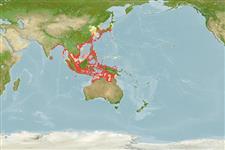Common names from other countries
Environment: milieu / climate zone / εύρος βάθους / distribution range
Οικολογία
Θαλασσινό(ά); Γλυκού νερού; Υφάλμυρο pelagic-neritic; αμφίδρομο (Ref. 51243); εύρος βάθους 0 - 50 m (Ref. 189). Tropical; 42°N - 17°S, 81°E - 147°E (Ref. 189)
Eastern Indian Ocean: northern and eastern Bay of Bengal coasts, including the Andaman Islands; perhaps southward from the Godavari river. Western Pacific: northern coast of Australia, Arafura Sea (Ref. 9819), Gulf of Papua, Sarawak, presumably the Philippines and Hong Kong; China from Taiwan north to Yellow Sea and southern part of Sea of Japan.
Μέγεθος / Βάρος / Age
Γεννητική Ωρίμανση: Lm ? range ? - ? cm
Max length : 22.0 cm SL αρσενικό/απροσδιόριστο; (Ref. 9822); μεγ. δημοσιευμένο βάρος: 44.25 g (Ref. 124713)
Ραχιαίες άκανθες (συνολικά) : 0; Εδρικές άκανθες: 0; Μαλακές εδρικές ακτίνες: 46 - 56. Belly with 18 to 20 (rarely 17 or 21) + 7 (sometimes 8) = 25 to 27 keeled scutes from isthmus to anus. Lower gill rakers with the serrae uneven, with slight or sometimes distinct clumps of larger serrae. Pectoral filament moderate, reaching back to base of 9th to 21st anal fin ray.
Body shape (shape guide): elongated; Cross section: compressed.
Presumably schooling and occurring mostly in coastal waters, but also entering estuaries (Ref. 11230) (e.g. the Hooghly and Godavari in India) and penetrating at least 20 km up the Godavari, tolerating salinities as low as 8.7 ppt. Feeds on prawn, copepods, crustacean larvae, mollusks and fishes. Fairly common (Ref. 189).
Life cycle and mating behavior
Γεννητική Ωρίμανση | Αναπαραγωγή | Γεννοβολία | Αβγά | Γονιμότητα | Προνύμφες
Wongratana, T., T.A. Munroe and M. Nizinski, 1999. Order Clupeiformes. Engraulidae. Anchovies. p. 1698-1753. In K.E. Carpenter and V.H. Niem (eds.) FAO species identification guide for fishery purposes. The living marine resources of the WCP. Vol. 3. Batoid fishes, chimaeras and bony fishes part 1 (Elopidae to Linophrynidae). FAO, Rome. (Ref. 9822)
IUCN Red List Status (Ref. 130435: Version 2025-1)
Threat to humans
Harmless
Human uses
αλιεία: περιορισμένης εμπορικότητας
Εργαλεία
Special reports
Download XML
Διαδικτυακές πηγές
Estimates based on models
Preferred temperature (Αναφ.
123201): 24.7 - 29.1, mean 28.4 °C (based on 948 cells).
Phylogenetic diversity index (Αναφ.
82804): PD
50 = 0.5039 [Uniqueness, from 0.5 = low to 2.0 = high].
Bayesian length-weight: a=0.00447 (0.00267 - 0.00747), b=3.10 (2.96 - 3.24), in cm total length, based on LWR estimates for this species & (Sub)family-body (Ref.
93245).
Τροφικό Επίπεδο (Αναφ.
69278): 3.6 ±0.51 se; based on food items.
Ελαστικότητα (Αναφ.
120179): Υψηλό, ελάχιστος χρόνος για διπλασιασμό πληθυσμού < 15 μήνες (Preliminary K or Fecundity.).
Fishing Vulnerability (Ref.
59153): Low vulnerability (17 of 100).
🛈
